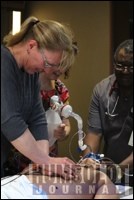April 22 was a busy day at the Humboldt District Health Complex, full of rare but serious cases. One patient arrived having suffered a heart attack; another was dealing with a life-threatening infection. Doctors, nurses and paramedics worked feverishly to save the patients, all while dealing with sudden and unexpected changes to their conditions.
Fortunately for everyone involved, the patient was a lifelike mannequin named Stan. While Stan can breathe, bleed and speak, he was in no danger of living or dying. In fact, he was there as part of the Mobile Education Unit (MEU), a new training initiative by STARS that sees a huge motorhome travel to rural areas across the province, training doctors and other health care providers in simulated, high-risk scenarios. The program is free and began in March with the plan that three rural areas would be visited a month. After Humboldt, the MEU would be traveling to Rosetown on April 23 and Melfort on April 30.
"We want to simulate rare events, the type of thing that might happen once a year or so," said Dr. John Froh, an emergency physician based in Saskatoon who also serves as medical director for STARS.
Froh was standing inside the MEU motorhome, a big red machine that's hard to miss, with Stan strapped to a gurney behind him. Wires dangled from intravenous units as the last doctors and nurses from Humboldt finished up their final simulation. Throughout the day there had been 41 participants, including six of the 13 doctors that are on staff in Humboldt.
"There was no hesitation as to whether we were going to do it," said Yvonne Berscheid, the site manager at the Humboldt District Health Complex.
Back inside the MEU, Froh demonstrated the type of training offered by inserting a breathing tube into Stan. It's a somewhat violent process that wouldn't be done on a live patient unless necessary, so there aren't many opportunities for doctors to practice, especially in rural areas. Closing that opportunity gap is at the core of what the MEU is all about.
"The money and time isn't always there in some of the rural areas," said Cindy Seidl, STARS' base director of Saskatoon operations. "If there's a conference going on in Saskatoon or Regina it's just not feasible to have all of the staff who would benefit from it go. If they did there wouldn't be anybody left to provide care."
According to MEU staff, there are also real benefits to training with the same people you work with on a day-to-day basis. The dynamics of an emergency situation are often like that of a sports team, and practicing with your teammates should naturally lead to better execution when it comes to the real thing, where there's no room for error.
"We want to create a realistic simulation with familiar team members," Froh said.
While it might be tempting to dismiss the MEU training as preparation for unlikely scenarios, the truth is that these sorts of medical emergencies do occur. In fact, the day after going through a diabetic coma simulation with staff in Shelbrooke, MEU staff found out that the very same thing had happened the next day, but this time it was a real-life scenario.
The MEU program has been operating in Alberta since 1999 and was the first mobile program of its kind in North America.
It's been in operation in Saskatchewan for just over a month, but the plan is to keep the big red motorhome chugging through the rural parts of the province indefinitely. By the end of it Stan will have suffered countless heart attacks and innumerable aneurysms, but it will have been worth it.




